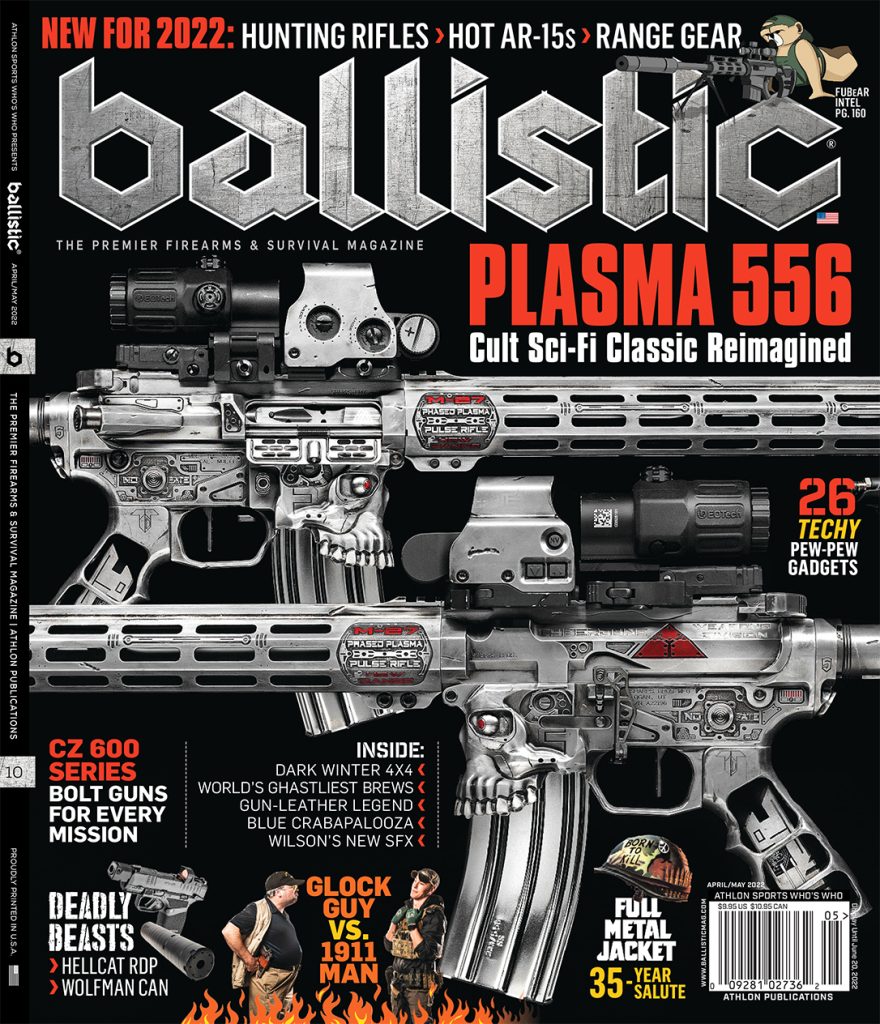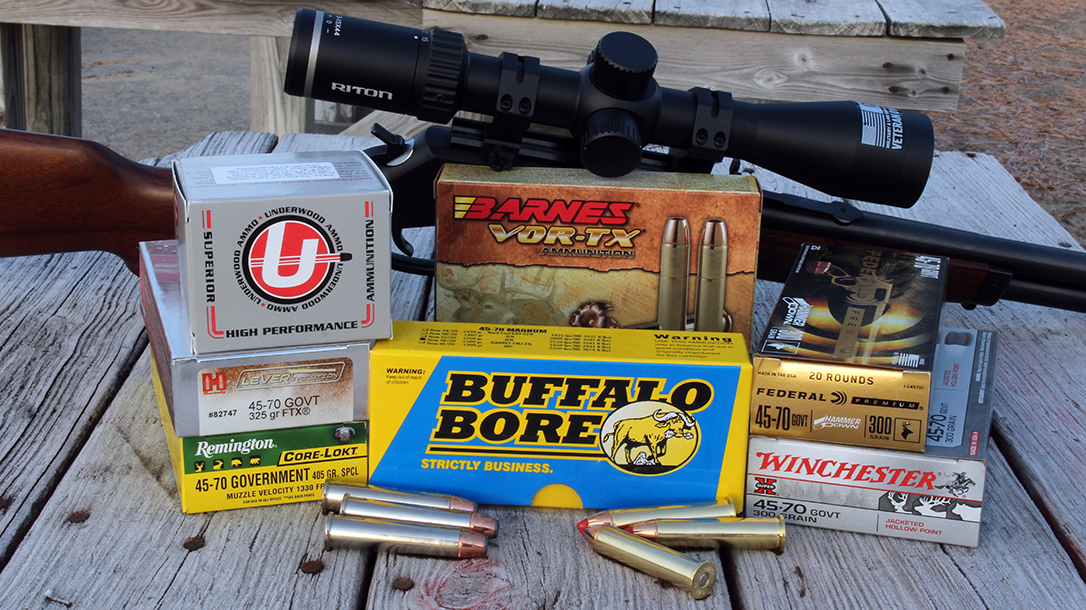There’s a saying that floats through our ranks that goes something to the tune of “what kills on Sunday, sells on Monday.” Although it sounds grim, it simply implies that whatever gets adopted by the military will invariably become popular in the civilian market as well. This becomes plain to see once we consider how many of our friends own items like EOtech holo sights, M9 pistols and Humvees. The reason behind this phenomenon is pretty obvious as well, the equipment simply works. While my examples reference modern-day gear, this trend had been prevalent for more than 100 years.
To prove my point, I shall direct your attention to the .45-70 Govt cartridge. Adopted back in 1873, this cartridge served soldiers through such conflicts as the Spanish-American war and almost immediately became a top pick for hunting game as small as whitetail deer to as large as African elephant. This range of animals quickly illustrates the versatility of the old straight-walled cartridge, and as such, I was determined to round up a few unique offerings to see how they faired through a modern lever gun.
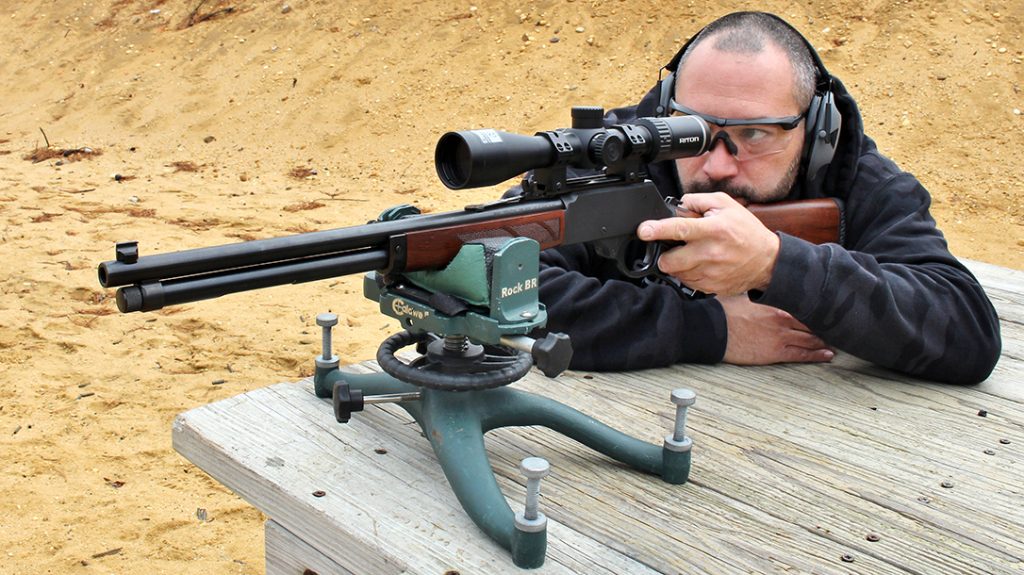
Advertisement — Continue Reading Below
Hunting the Best .45-70 Cartridges
The gun in question is a Henry H010—a piece that does not get nearly enough time on the range or in the field. This 18.43-inch barreled American masterpiece is short enough for even the thickest brush or the smallest ground blind and is balanced and padded just right to control the recoil of this monster of a cartridge. After a quick cleaning, I topped the rifle off with one of Riton’s newer hunting scopes, the 3-15×44 X3 Primal, and before I knew it, I had a brush-busting package that Teddy Roosevelt himself would be proud of. All that was left was to gather up a hernia’s worth of ammunition as well as a G3 chronograph and Rock BR rest from Caldwell, which with these items I would be ready to rock my shoulder like it’s never been before.
Barnes VOR-TX
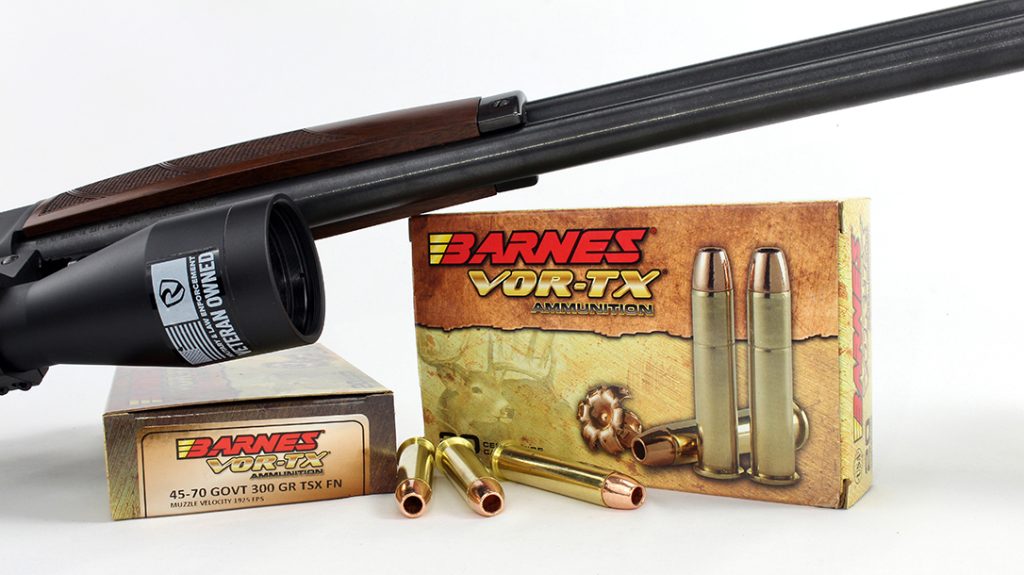
Barnes VOR-TX ammunition is becoming a staple to the Ammo Match column, there’s no hiding it. As this round is available in the most popular hunting cartridges in the country, my goal is to one day try every one that I have a rifle for. This all-copper bullet is built with a ginormous cavity that quickly expands once it contacts flesh. During expansion, it peels back into four devastation pedals and eventually comes to a crashing halt. The recoil on this round was moderate and its middle-ground energy level makes it a perfect whitetail candidate, as it will deal swift death without wrecking too much meat. (barnesbullets.com)
Advertisement — Continue Reading Below
Buffalo Bore
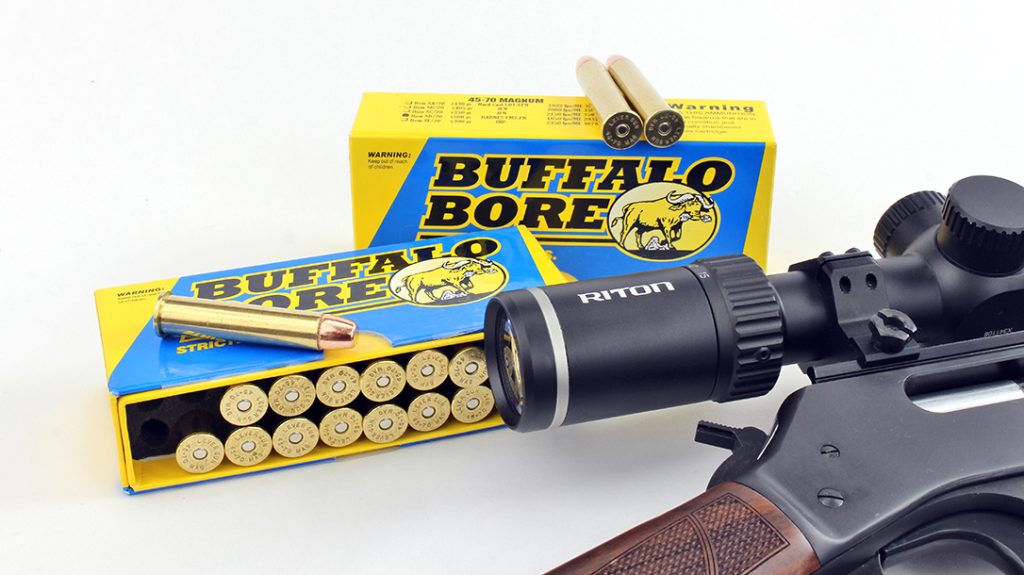
Buffalo Bore specializes in squeezing every last ounce of performance out of a given cartridge and given the volume of a .45-70 case, they had plenty of room to work with. Featuring a 500-grain full metal jacket bullet, these bad boys were no joke. So much so that you can feel the difference in the hand the moment you pick one up. This case was the only one of the seven that I would try that was built with a small primer and primer pocket, likely to help manage the pressure. I don’t want to say that the recoil was unpleasant, but let’s just say that this is the cartridge that you want to give to a buddy when you want them to get the full .45-70 experience. Aside from fun, this should be your go-to when you seek maximum penetration for animals like brown bear. (Buffalobore.com)
Federal Hammer Down
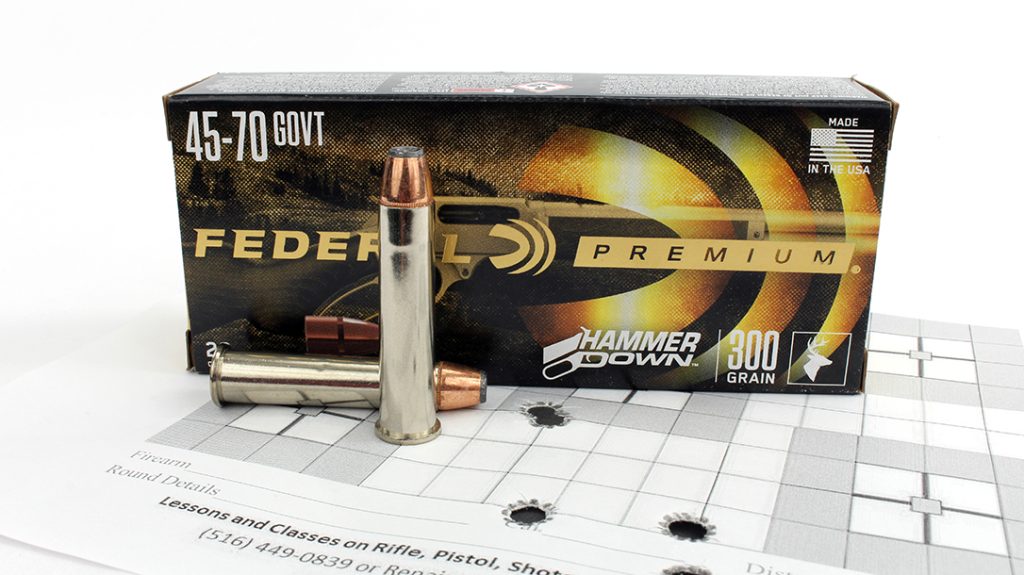
Advertisement — Continue Reading Below
Unfair advantage alert right here folks. I say this because Federal worked in conjunction with Henry Repeating to produce this line of ammunition. Therefore, it was built specifically to shoot well in the gun that I was testing all seven loads in. I say unfair because it essentially was like shooting a custom handload against a sea of seemingly random offerings. The accuracy report shows that this was indeed the case, even though the standard deviation suggests otherwise.
Hammer Down is built with the best blend of powder and bonded soft-point bullets to provide maximum accuracy and terminal performance out of this platform, but some might argue nothing is more unique than the case that everything is loaded into. Aside from the sealed primers and nickel plating, these cases are made with a special tapered rim that allows them to slip right through a loading gate and also don’t hang up as much when you are trying to slide a spring-loaded rod over them. (federalpremium.com)
Hornady Lever Evolution
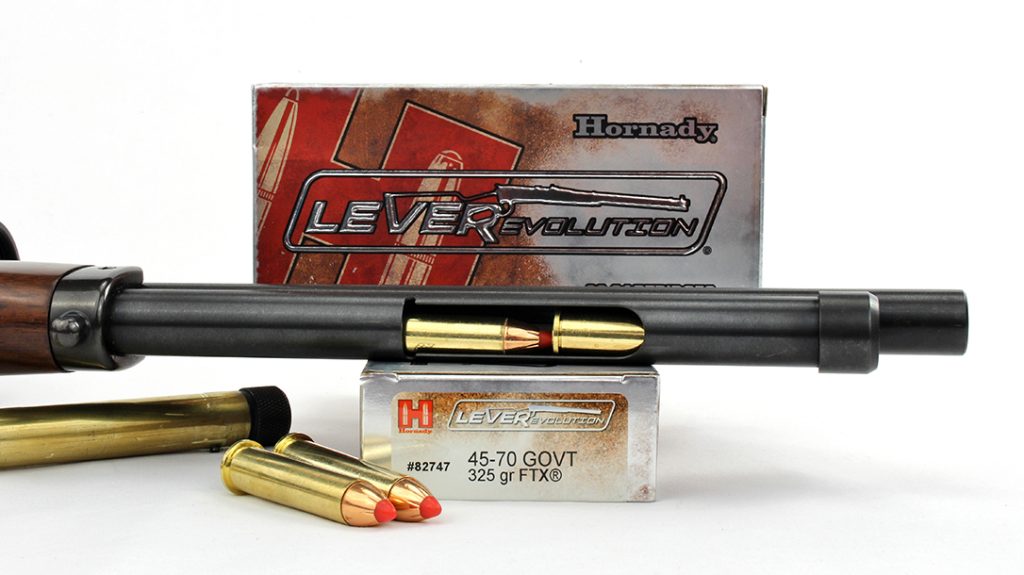
Advertisement — Continue Reading Below
For those of you who are not aware, Spitzer bullets in tubular magazines are a big no-no, as the tip of one projectile lies directly against the primer of the one in front of it. Because of this, a strong enough bang or even the right recoil pulse can detonate rounds inside of the magazine, turning that sheet metal tube into a frag grenade. Let’s face it, if there was ever a candidate for a recoil-activated catastrophe, it would be .45-70 Govt For this reason, most lever-action bound ammo is built with blunt bullets that suffer from poor ballistic performance.
In an effort to solve this, Hornady introduced the FTX projectile with its soft rubber point. This design is safe for a tube and cuts through the air more like a needle and less like a sail. Recoil was a little sharp on these guys, but after crunching the numbers we found them to be extraordinarily efficient, turning all of that punch into downrange energy. (hornady.com)
Remington Core-Lokt
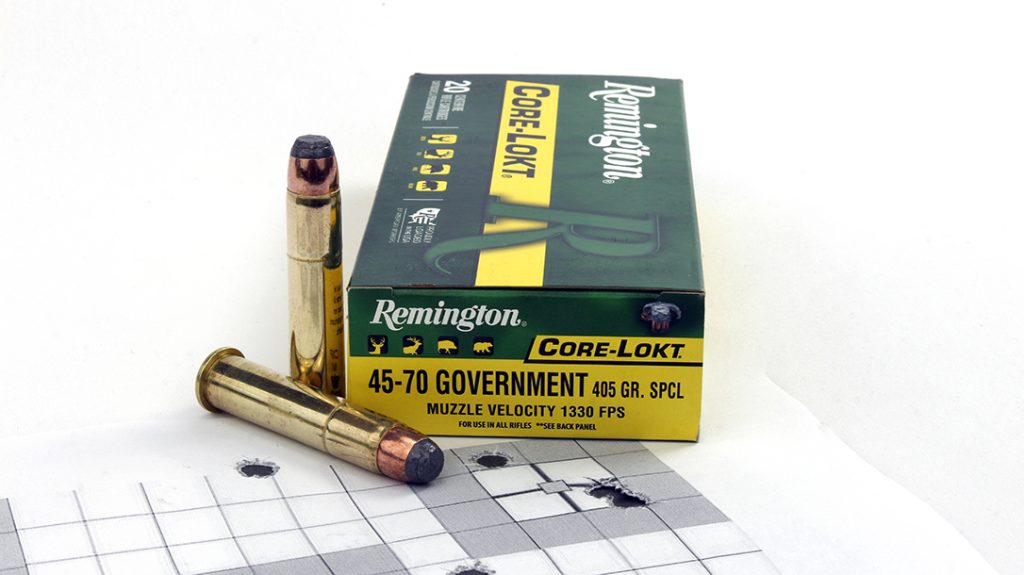
Advertisement — Continue Reading Below
I’m not gonna lie, it was a little touch-and-go back there without Core-Lokt ammunition on the shelves for a few months. Luckily, most of the classic offerings came back with the new ownership including this unique loading of the 405-grain Core-Lokt bullet. As .45-70 was originally intended for black-powder firearms, there are many “weak” action styles out there, like that of a Trapdoor Springfield. For this reason, reduced pressure loads like this one exist.
Remington differentiates this from its standard 405-grain .45-70 load with the “SPCL” marking on the packaging, so make sure that you are buying the right stuff if you’re feeding one of the classics. This stone of a bullet is marketed as flying at 1,330 fps, which I wholeheartedly believe would be the case through the 22- or 32-inch barrels of those guns, but we only saw an average of 910 fps through the shorter barrel of our Henry. That makes this round a perfect candidate for home defense, right as the “tactical lever gun” is taking its foothold in the market. 744 fpe is nothing to sneeze at, coming in at more than twice most 9mm Luger rounds, and by not breaking the sound barrier this is going to be much easier on your ears if fired indoors.
Subsonic ammunition is also synonymous with accuracy, and it came in second on our list in this department. This list of features makes this a great target round, especially since it has recoil that was on par with light .30-30 rounds. (remington.com)
Advertisement — Continue Reading Below
Underwood +P Xtreme Hunter
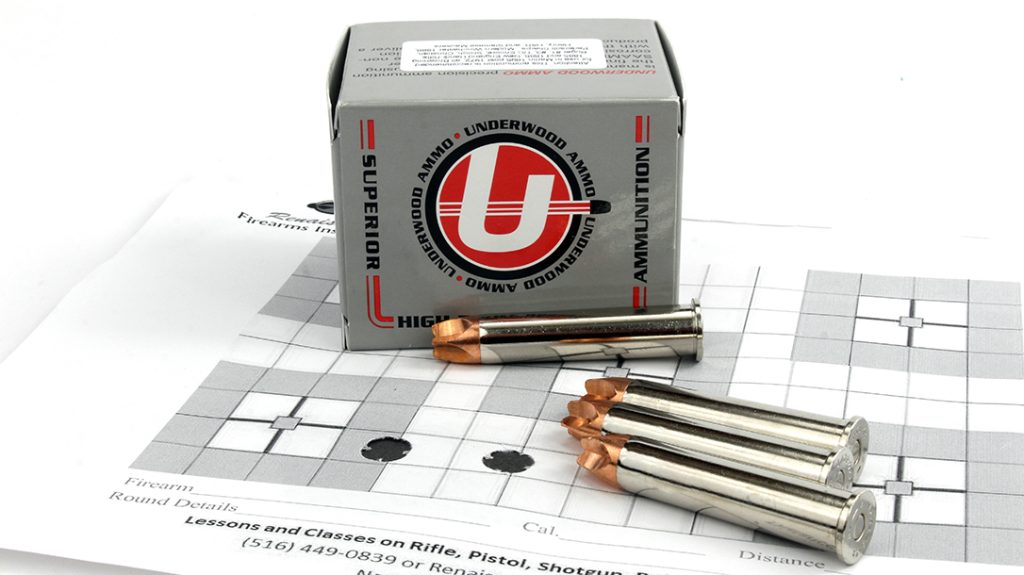
Underwood Xtreme Hunter is an interesting round both to look at as well as to shoot. This bullet is constructed of solid copper and is designed to crash through barriers such as thin brush and thick hide or bone to get to a liquid medium. Once inside that medium, it displaces said liquid in an outward fashion generating a wound cavity that is far greater than conventional hollow-point ammunition.
Although they were the lightest bullet that I fired that day, they generated the most energy out of all the rounds tested. This is largely because these things were flying at upwards of 2,400 fps. The recoil pulse was intense but short, generating a dramatic fireball and muzzle rise but very little shoulder thump. Impacts on paper are fun to look at too, as they leave a unique hole that shows off the bullets’ profile, and that in turn shows me that they are landing on target as intended. (underwoodammo.com)
Advertisement — Continue Reading Below
Winchester Super-X
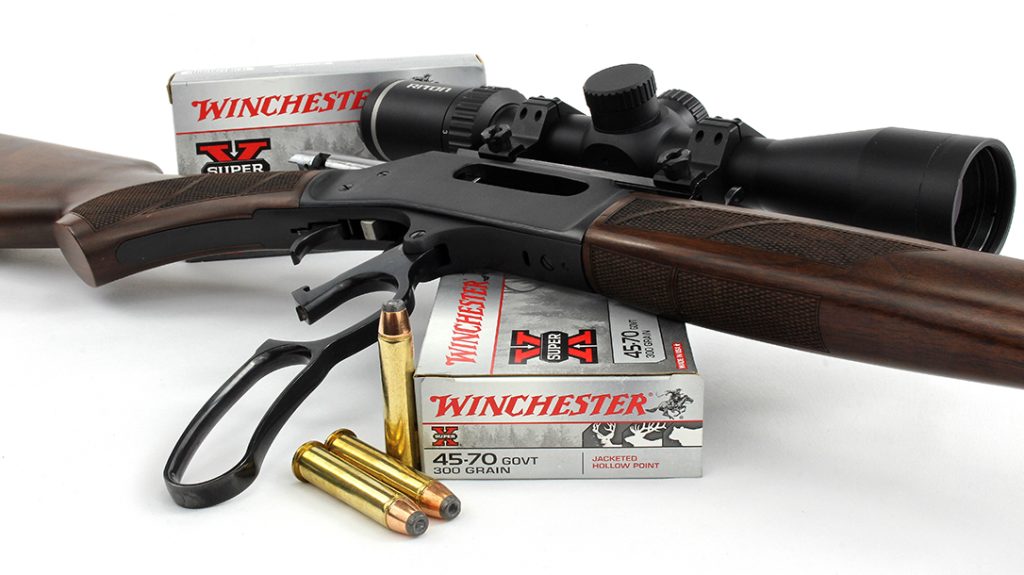
A .45-70 Govt roundup wouldn’t be complete without Winchester Super-X. This ammo company is arguably the most closely associated manufacturer with this cartridge and has likely been loading it longer than any of the other players in this article. This load features a 300-grain jacketed hollow-point bullet that is designed to be effective on nearly anything that walks, crawls or swims in North America. In our testing, it proved to land in the middle of the accuracy and velocity charts and pretty high up in the energy category too. This makes it another great choice for a do-all cartridge as it is strong enough for bear but gentle enough for deer and high-volume target work. (winchester.com)
Gel Report
Whenever I am working with ammo that is built to react to flesh, I like to test it with ballistics gel to see what a recovered bullet looks like. However, in the case of 45-70, I would likely have had better success trying to stop a freight train with a stack of pillows. Even the mildest rounds penetrated two full 16-inch blocks of Clear Ballistics 10% FBI gel placed more than 100 yards away and were never to be seen again.
Advertisement — Continue Reading Below
Although we didn’t have any bullets to look at, the impact for the Hornady Lever Evolution round was quite intriguing. After initial contact, that soft flex tip rolled away with just a few pieces of the bullets jacket. Just forward of this event, we found a long, wide wound cavity that showed us that the bullet delivered substantial shock and did indeed continue its path towards what would be the animal’s vitals. That’s a perfectly functioning bullet in my book and I’m excited to try it on some meat come next hunting season.
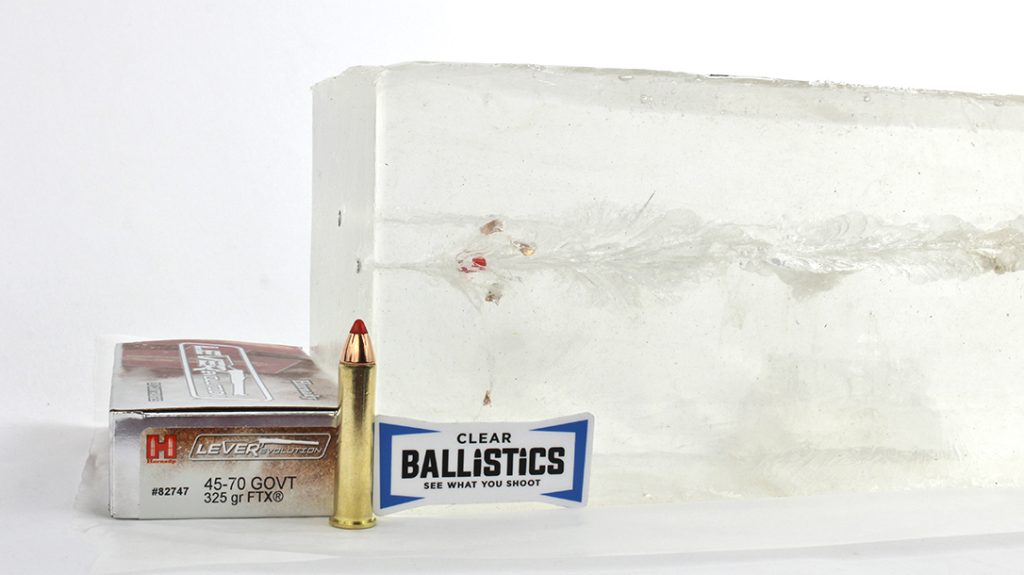
The Breakdown
As I looked over my notes, targets and blocks of gel, there wasn’t a clear winner or loser, which is typical when comparing munitions. Across the board, everything produced about the same accuracy when you consider the intended purpose is for hunting or engaging steel plates that are likely on the order of 10- 12 inches at distances of not much more than 100 yards. “Intended purpose” should be the key phrase here and that should help guide you towards your decision of which round to stock up on.
Our testing revealed offerings that were great for self-defense, target work, medium game, large game and even just plain old thrill-seeking. Also, it pays to note that what was outstanding in one gun might lackluster in another, as is the case with all (yes, all) ammunition. So, for those just setting out, it might not be a bad idea to try a box or two of as many manufacturers fodder as you can. I just happen to know of seven that I can recommend right off the bat.
MODERN MARVEL: MARLIN 1895 SBL
Ruger’s acquisition of Marlin has brought a resurgence to the Marlin brand. The once beleaguered and bankrupt company now comes out swinging with the introduction of the Marlin Model 1895 SBL chambered in the classic .45-70 Govt round. Originally developed for use in the Springfield Model 1873, which is known as the “Trapdoor Springfield.” A lot has changed since the round’s development in 1873, but hunters and shooters’ thirst for the ubiquitous round has not waned. Marlin helps meet this demand with its latest offering.
The basic design is still the same but with some appreciable upgrades such as the nickel-plated, fluted bolt for butter smooth cycling along with a cold hammer-forged barrel. A refined stock features a thinner forend and improved finish on both forend and checkered grip panels for a sure grip. A rear ghost ring sight and tritium fiber-optic front sight get shooters on target quick while the top of the receiver and barrel sports an updated Picatinny rail for adding modern optics. In addition, the threaded barrel accommodates muzzle breaks or other barrel accessories that fit the 11/16×24 pattern. A match-polished, factory-installed thread protector caps the barrel for protection. For more, visit marlinfirearms.com. —Greg Duncan
- Read our full review of the Marlin 1895 SBL

This article originally appeared in the April-May 2022 issue of Ballistic Magazine. Get your copy or digital subscription at OutdoorGroupStore.com.
